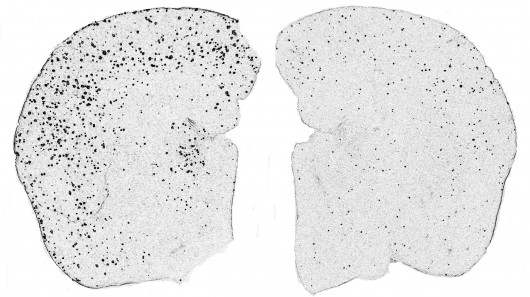
Plaque deposits in the brain tissue of an untreated mouse (left), and one treated in the study
By turning off an immune system transmitter in mice with an Alzheimer’s-like condition, scientists have been able to greatly reduce the accumulation of an abnormal protein known as amyloid-ß in the animals’ brains. Previous studies have shown that the protein plays a central role in Alzheimer’s disease. It is hoped that the research may ultimately point the way towards a method of preventing or treating the disease in humans.
The project was led by Prof. Frank Heppner from Charité - Universitätsmedizin Berlin, and Prof. Burkhard Becher from the University of Zurich.
In mice that had a build-up of amyloid-ß “plaque” in their brains, the scientists blocked an immune molecule called p40, which is a component of the cytokines (immune system signal transmitters) interleukin (IL)-12 and -23. This effectively turned off those cytokines, which in turn reduced the animals’ plaque build-up by up to 65 percent.
In a follow-up study, in which an antibody was used to block the p40 molecules of afflicted mice, substantial improvements in their behavioral testing resulted. This ties in with the scientists’ observation that p40 levels are higher in the brain fluid of Alzheimer’s patients, and with a previous study that noted high levels of the molecule in patients’ blood plasma.
Heppner and Becher are still trying to understand the exact cause/effect relationship between p40, the cytokines and Alzheimer’s, but hope to move on to clinical human trials soon. There are already p40-blocking medications for conditions such as psoriasis, that have been shown to be safe.
In a separate study conducted at Ohio’s Case Western University, an anticancer drug has also been used to reverse Alzheimer’s symptoms in mice.
A paper on the p40-blocking research was recently published in the journal Nature Medicine.
Source: University of Zurich
About the Author
Copyright © gizmag 2003 - 2012 To subscribe or visit go to: http://www.gizmag.com
